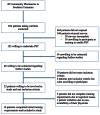Supervised patient self-testing of warfarin therapy using an online system
- PMID: 23853350
- PMCID: PMC3713938
- DOI: 10.2196/jmir.2255
Supervised patient self-testing of warfarin therapy using an online system
Abstract
Background: Point-of-care international normalized ratio (INR) monitoring devices simplify warfarin management by allowing selected patients to monitor their own therapy in their homes. Patient self-testing (PST) has been shown to improve the clinical outcomes of warfarin therapy compared to usual care.
Objective: To compare management of warfarin therapy using PST combined with online supervision by physicians via a custom system with usual warfarin management, which involved laboratory testing and physician dosing.
Methods: Interested patients were recruited via community pharmacies to participate in a warfarin PST training program. Participants were required to have a long-term indication for warfarin, have been taking warfarin for at least 6 months, and have Internet access in their home. The training involved two sessions covering theoretical aspects of warfarin therapy, use of the CoaguChek XS, and the study website. Following training, patients monitored their INR once weekly for up to 3 months. Patients and physicians utilized a secure website to communicate INR values, dosage recommendations, and clinical incidents. Physicians provided a 6-12 month history of INR results for comparison with study results. The percentage of time spent within the therapeutic INR range (TTR) was the primary outcome, with participants acting as their own historical controls. The percentage of INR tests in range and participant satisfaction were secondary outcomes.
Results: Sixteen patients completed training requirements. The mean age of participants was 69.8 (SD 10.1) years. TTR improved significantly from 66.4% to 78.4% during PST (P=.01), and the number of tests within the target range also improved significantly (from 66.0% at prior to the study to 75.9% during PST; P=.04). Patients and physicians expressed a high degree of satisfaction with the monitoring strategy and online system.
Conclusions: PST supported by an online system for supervision was associated with improved INR control compared to usual care in a small group of elderly patients. Further research is warranted to investigate the clinical outcomes and cost-effectiveness of online systems to support patients monitoring medications and chronic conditions in the home.
Keywords: Internet; communication; international normalized ratio; management; self-care; warfarin.
Conflict of interest statement
Conflicts of Interest: The authors have received funding from Roche Diagnostics Australia, who also provided CoaguChek XS devices and consumables for this project. The study sponsors and funder did not have any involvement in the study design, the collection, analysis or interpretation of data, the writing of the manuscript, or the decision to submit the manuscript for publication.
Figures



References
-
- Ansell J. New oral anticoagulants should not be used as first-line agents to prevent thromboembolism in patients with atrial fibrillation. Circulation. 2012 Jan 3;125(1):165–70; discussion 170. doi: 10.1161/CIRCULATIONAHA.111.031153. http://circ.ahajournals.org/cgi/pmidlookup?view=long&pmid=22215891 - DOI - PubMed
-
- Tang EO, Lai CS, Lee KK, Wong RS, Cheng G, Chan TY. Relationship between patients' warfarin knowledge and anticoagulation control. Ann Pharmacother. 2003 Jan;37(1):34–9. - PubMed
Publication types
MeSH terms
Substances
LinkOut - more resources
Full Text Sources
Other Literature Sources
Medical
Research Materials
Miscellaneous

